I thought I’d show how we make ice cream these days. It’s an easy dessert to make, and great for kids. They may even help in the cleanup by licking the utensils!
We’ve adopted rice syrup as a sweetener lately. The nice thing about “safe starch” syrup is that the dessert can be made as sweet as one likes, without the health concerns of fructose. With sucrose, I felt obliged to minimize the sweetness.
We’ve also begun to use lemon juice in a lot of our cooking, since the citrate offers a number of health benefits. We’ve come to like the citrus flavor and fragrance in our ice cream too.
With these innovations, our basic formula for ice cream is:
- 2 cups (1 pint) heavy cream. Ideally, the cream should be free of carrageenan, skim milk, or other additives, as discussed in this thread.
- 6 egg yolks
- 2 tablespoons rice syrup (more can be drizzled on when it’s done to accommodate those with a sweet tooth)
- 1 lemon (juice and some meat)
- berries, nuts, and other flavorings to taste
Today we made blueberry ice cream.
Some ingredients:
In the blender, before and after:
The ice cream maker:
This has a neat design: the pot that holds the ice cream is frozen beforehand (which requires 48 hours), and it mounts on a motor and turns. The rest of the ice cream maker is stationary; a stationary paddle churns the mixture as the pot turns.
Here we are pouring in the mixture:
And 15 minutes later it’s done:
And served:
Shou-Ching is the one with the sweet tooth!
UPDATE: Calorie Counts
For those concerned with such things, here’s the calorie breakdown of the ice cream:
| Ingredient | Carbs | Fat | Protein |
| Rice syrup, 2 tbsp | 150 | ||
| Blueberries, 2 cups | 170 | ||
| Egg yolks, 6 | 246 | 12 | |
| Cream, 1 pint | 24 | 780 | 16 |
| TOTAL: | 344 (25%) | 1026 (73%) | 28 (2%) |
Fructose from the berries represents about a quarter of the carb calories or 7% of total calories.







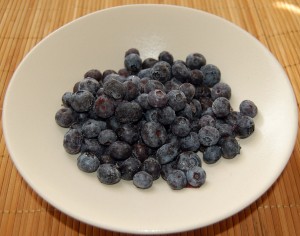
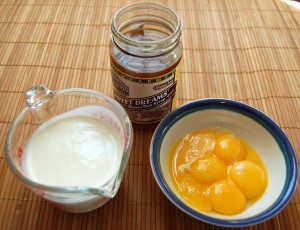
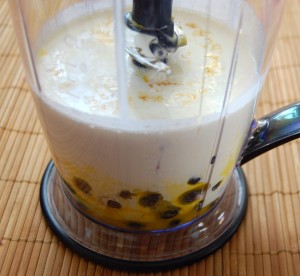
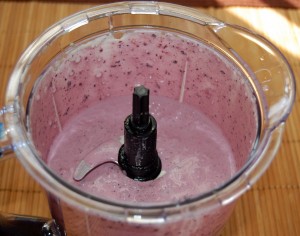
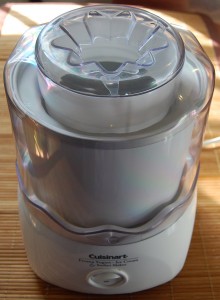
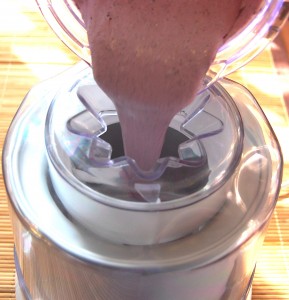
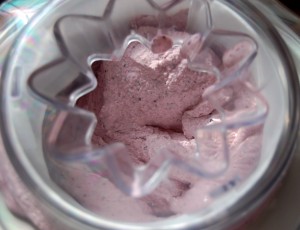
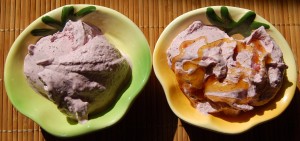




Looks great!
How noisy is your ice-cream maker? I’ve been considering getting one, but I’ve read so many complaints about how noisy the better motorized ones can be. I live in a small place, so noise is a concern. I don’t want to have to put it into a closet. lol
I don’t like the manual ones, like Donvier.
Hi Lillea,
It starts off quiet and gets noisier as the ice cream thickens. The noise tells you it’s done.
If we are watching a movie, we make the ice cream in the next room and close the door. We can still hear it when it’s finishing up, but it doesn’t prevent us from watching television.
Since the noise is only a problem for 5-10 minutes, and you don’t have to stay in the room with it, it doesn’t bother us. But I suppose you could throw towels over it to muffle the sound!
Thanks for the recipe! If ice cream with real sweetener is on the menu, I think I might finally be able to get my fiance on board with this healthy eating plan 🙂
Hi Leah,
Healthy can be tasty! In fact, if it isn’t, I question whether it’s healthy. We evolved to like what’s good for us.
This is similar to what I’ve been doing, but with stevia or sugar alcohols. Are there any problems you know of with these sweeteners?
And thank you for introducing me to rice syrup. It’s not orthodox paleo so I would never have tried it but for you.
Hi Abby,
Stevia and sugar alcohols are fine, we recommend them on our supplements page.
But since it’s good to obtain moderate amounts of glucose, we see nothing wrong with rice syrup.
How can you tell that the rice syrup has not been partially converted to fructose as is typically done with corn syrup? From what I remember reading about corn syrup, initially it’s all glucose but they process it to turn some of it into fructose because fructose tastes much sweeter than glucose and therefore they don’t have to use as much to make a product taste sweet (making the product cheaper).
My personal process involves using half rice syrup and half real stevia.. to much stevia tastes nasty but I find any time you mix stevia with a normal sugar it tastes much much better. I would use Paul’s 2 tablespoons and add stevia to taste.
Hmmm … good question, Bryan. I hadn’t considered that possibility. It can be a challenge staying one step ahead of the food companies.
Since our rice syrup comes from pretty small companies, with an emphasis on organic, natural, I doubt they’d be doing that kind of processing. But nothing on the label says what kinds of sugars are in the syrup.
I looked up the web site of the brand we used today, and they say their syrup is “half as sweet as sugar” (http://www.lundberg.com/Products/Syrup.aspx). I take it that means it’s glucose, not a glucose-fructose mix.
I’m pretty sure the other rice syrups we’ve seen and recommended are also pure glucose. But I would certainly avoid any brand that converts rice sugars to fructose.
This should put the question to rest about Lundberg rice syrup. From their website: . “Rice syrup is composed mainly of maltose and maltotriose, a sugar in the same group as sucrose (table sugar) and lactose (milk sugar).”
I love your blog. I have recovered from Lyme disease using a very similar dietary approach. I did have a stint where I was a very strict paleo, but that made the cravings for sweets almost insatiable. With the added starches in something like PHD, I have almost NO cravings. That’s saying a lot for me! I also used a variety of supplements and cats claw as the primary “bug killer”. My naturopath very closely mirrored Stephen Buhner’s (I think that’s his name) approach in his book Healing Lyme. As a result, I’m a huge fan of a healthy, ancestral diet and herbs!
Anyways, we have that same ice cream maker (found at Goodwill for $3) and love it. I’m dairy sensitive, so I use coconut milk and stevia. It’s also nice to see you use Lundberg rice syrup. They are a good company and that syrup is quite good, too 🙂
Thank you for your wonderful blog!
Jamie
Hi Jamie,
You’re welcome! As long as we believe we are helping people, we’ll keep doing it.
Best, Paul
Thanks Paul! Sounds like it’s fairly quiet compared to some models. Great. 🙂
Assuming the rice syrup is all glucose, I wonder how many glucose grams are in the final product per serving.
I also still love ice cream and indulge now and then in “no sugar added” ice cream from scoop shops. But the sugar alcohols in them cause gas and bloating, and I’m not 100% sold on the safety of Splenda, the most common artificial sweetener in them. So this is an interesting idea.
Hi Bill,
I’ve added a calorie table as an update to the post.
You could add more rice syrup and it would still be in the Perfect Health Diet range. Remember we aim for around 2/3 fat calories in all dishes, so carb dishes should be 1/3 carb 2/3 fat and meat dishes 1/3 protein 2/3 fat, thus carb+protein sum to 33% and fat to 67%.
This ice cream was a little carb light by that standard.
Best, Paul
I’ve been experimenting with similar recipes. But when you store in the freezer it goes rock hard!!!!
Any solutions to achieving soft icecream, without the sugar in shop bought ones?
THanks
Most ice cream companies add a form of anti-freeze to make ice cream scoopable, but “Nourishing Traditions” recommends 1 or 2 tablespoons of Vodka to achieve a similar effect.
Hi Eddy,
It does indeed become rock hard.
I just take it out of the freezer and set the container on the counter. Half an hour later, it is soft and easy to serve.
The higher the sugar content, the softer the ice cream and the easier to scoop. You could try the above recipe with 4 tbsp rice syrup, it might be soft enough for you.
Best, Paul
You just use raw yolks? I suppose it’s probably not too risky, but I figured heating the custard would have some effect on the final texture.
thanks
Hi Carl,
Yes, we use raw yolks. According to this, there are about 50 outbreaks per year of salmonella from raw eggs: http://missourifamilies.org/features/foodsafetyarticles/fdsftyfeature10.htm
It’s a small risk for a healthy person, but those who are vulnerable to infections might try egg-less frozen yogurt or sherbet, or cook the egg yolks in the cream to 160 F before using it in the ice cream.
If you buy Dextrose that is derived from corn, is that a safe starch?
Hi Mark,
No, it’s not a safe starch. On the other hand, my understanding is that the protein levels in dextrose are something like 95% lower than the protein levels in corn itself. Since it’s the proteins that are toxic, the toxin levels should be much lower.
For coeliacs eating wheat 95% wouldn’t be good enough, but I think with corn it is acceptable.
Thus, we include a corn-derived dextrose powder on our recommendations page: http://perfecthealthdiet.com/?page_id=1066.
However, given my druthers I’d rather eat a rice-derived sweetener.
Hi, I’m a recent fan of PHD, blog reader and am working my way through the book.
I recently was diagnosed with “complex migraines” – the symptoms of which are like a stroke w/ a migraine.
I am reading through how to potentially use the ketone diet to help alleviate the migraines … and was lamenting cutting back decadant sweets like ice cream due to the sugar, and was waiting to get to the point where you recommended giving up all artificial sweeteners. I hate stevia, but really like Blue Agave Syrup.
Is this safe sweetener? If not, now I have rice syrup to try … but I’d like to have a few options.
Thanks for such great information!
Hi Katie,
Welcome!
If you are on a ketogenic diet then you may want to consider zero-calorie sweeteners like the sugar alcohols erythritol or xylitol, or perhaps mixes with stevia like truvia.
Agave is mainly fructose which we are inclined to avoid. Fructose tends to aggravate gut infections; conceivably there could be a gut-brain relation involved in migraines.
I would try the glucose-rich safe starch sweeteners if you want carb calories, the sugar alcohols if you don’t. Some possibilities are mentioned on our supplements page: http://perfecthealthdiet.com/?page_id=1066.
I did say that I favor rice syrup over zero-calorie sweeteners, but that is a personal preference and not meant as a recommendation for others. On a ketogenic diet, I think you’ll find the sugar alcohols are better and you can still get some carbs from food.
Best, Paul
I have just bought a bottle of rice syrup at a health food store and as it was discussed here I`ll give you some information about the nutritional facts. On the label it is declared “fructose free” and “gluten-free”.
It has 78,5 g carbs
75,4 g sugar of which are
0,0 g fructose
21,9 g gluccose
33,9 g maltose which is probably maltrodexin in English?
16,6 g oligosaccharide (no idea how this translates into English)
It is pretty expensive 4,95 EUR/360 ml=500 g (probably around 7 $) but you don`t drink it from tha bottle…
Hi Iris,
That’s more expensive than we paid – $4 for 390 ml. Sounds like your nutritional labels are more detailed than ours. “Oligosaccharide” translates just fine – it’s the same in English!
Thanks, Paul
Hi Paul,
Thank you for the recipe.
What do you think of Tapioca syrup? Is it OK to use?
I recently bought a jar, but haven’t had a chance to taste it yet.
Ingredients: organic tapioca syrup.
Hi Mia,
Yes, tapioca syrup is great. Go for it!
I drink a shake very similar to this often in the mornings, it’s very delicious! My assumption though was that a shake of berries, cream, and coconut milk would allow me to continue my “fast” from the night before, triggering autophagy. Am I correct or mistaken? I know coconut milk and berries have some protein in them.
Hi Bill,
There will still be some autophagy, from continuing protein restriction, but the cream is much less ketogenic than the coconut oil.
But would insulin from whatever carbs and protein are in the drink stop autophagy? I’ve heard that insulin halts autophagy, but not sure if that’s true.
Hi Bill,
Yes, insulin inhibits autophagy. But if cells need amino acids, they’ll still do some autophagy to get it. There are many factors that determine how much autophagy occurs, insulin is only one.
My wife picked up a bottle of Coconut Nectar made from coconut tree sap. Claims to be mostly inulin. Was thinking it might be a safe carb but now this guy has me questioning whether the company is lying about its nutritional breakdown.
http://paleohacks.com/questions/11280/thoughts-on-coconut-sap-products#axzz1FSqlL0i6
Hi Matt,
I quoted you on another thread: http://perfecthealthdiet.com/?p=2517&cpage=1#comment-17552.
I’m not a big fan of inulin, my guess is that the fiber content of food is sufficient, we don’t need extra. But Beth says coconut water is high in potassium, that would be an asset. Do you know if these are the same?
Very different; nectar is tree sap, water is immature coconut meat, half sucrose 40% glucose 10% fructose. I responded in more detail back on that Pho thread. http://perfecthealthdiet.com/?p=2517#comment-17572
Thanks, Matt. Appreciate it.
Paul,
Can you tell me what makes sugar alcohols OK? What happens when you consume them? I’m guessing they don’t go to the liver like the alcohol in alcoholic drinks.
Hi Rodney,
They’re mainly eaten by gut bacteria, so they’re fiber-ish, but sweet tasting.
Mark Sisson had a good overview: http://www.marksdailyapple.com/sugar-alcohols/
For the first time, I found something interesting and useful on the Livestrong website ;-). I didn’t find much useful information on the www dot lundberg dot com website (that’s the rice syrup brand I have in my cabinet).
The Livestrong page discusses syrups made from grain starch (amylose): corn, rice, tapioca, sorghum (ignore the sponsored link that the corn sugar refiners insert in the article to promote HFCS propaganda).
http://www.livestrong.com/article/321733-brown-rice-syrup-vs-high-fructose-corn-syrup/
Note: elsewhere on the Livestrong website it says that sorbitol (a sugar alcohol) converts in the body to fructose. Then again, the Livestrong website is anti-naturally saturated fats, so I’d double-check anything on that site before putting it into practice. 😉
This ingredient manufacturer website also has some info on grain syrup sweeteners, including rice syrup.
http://www.briess.com/food/Products/ns.php
So far as I can tell with a little bit of googling around, it does seem syrups made from rice, tapioca, and sorghum are good options for people seeking low fructose or fructose-free sweeteners, as the syrups are essentially amylose starch enzymatically broken down into glucose & forms of maltose. Even old fashioned corn syrup (not HFCS) might be in this category, too, as far as I can tell, as it hasn’t been processed further to create the fructose content. Plain corn syrup definitely isn’t as sweet as HFCS pancake syrup, IME.
Of course, it’s good to remember to limit grain syrup sweetener consumption overall – being less sweet, it’s very easy to overuse rice syrup if one’s sweet taste receptors haven’t already been ratcheted down by a low sugar diet. One thing I’ve noticed with the explosion of “natural sugar” alternatives to white granulated sugar the past few years is that people tend to get giddy with the idea of a “safe” sugar, leading to a false sense of security and over-consumption.
Don’t forget to top it with some home-made “Magic Shell”.
We melt down a square of 100% cacao chocolate (you can use 75-80% if you don’t mind the small bit of fructose) and a tablespoon or so of coconut oil. Let it cool until it’s just above room temperature, but still liquid. Then pour it over the ice cream and wait for it to harden into a nice shell.
We did this last night and it was a blast from our childhood past, minus all the crap they put in the store-bought Magic Shell.
Hi,
For chocolate ice cream, is it best to use Natural Cocoa Powder or Dutch processed? Is this simply personal taste or would the dutch processing be considered harmful?
(I’m assuming this is unsweetened cocoa powder)
Thanks!
Mark
Hi Mark,
Since ice cream isn’t cooked, you can use either. So taste can decide.
Hi Paul
I am a Type 2 diabetic and have been low carbing for years and just never felt ‘right’. I have been following the PHD for a few days and am hoping it is the answer I have been looking for dietwise! Reading the blog on icecream got me thinking about the sweetners.
I have a question concerning Coconut Sugar. What do you think of it? I like that the GI is only 35 and the similar smell and taste to brown sugar. According to this webside: http://www.naturesblessings.com.ph/cocosugar.htm, the breakdown of cocnut sugar is: “Sucrose was the major component of all samples (70-79%) followed by glucose and fructose )3-9% each).”
Just curious if you think it’s safe or not, cause I really prefer it over Stevia for baking and icecream!
Thanks so much.
Thanks for this recipe – I spent a half hour last week in my supermarket reviewing ingredients lists on all their “ice creams” – the majority appear to be “ice skim milks” or “ice soya products” instead!
While searching further for recipes, I also discovered a machine-less method for making ice cream at home, which may interest some, although it does use some elbow grease (or keen and helpful company).
1. Spoon your stirred ice-cream mix into a ziploc bag – and firmly close.
2. Place the ice-cream mix bag, together with ice and some salt into a bigger ziploc bag – and firmly close.
3. Give all the waiting friends and relations a turn at shaking the whole thing until it looks ready. It can be wrapped in a couple of towels if it is too cold to hold. (You might need to have a couple of mixing bags on the go to accomodate everyone).
4. Remove the inner bag, keeping it firmly closed, from the outer one. Use scissors to cut a small triangle off of one corner and neatly squirt/swirl contents into bowls.
Hi Kathryn,
It’s similar to brown sugar. If you keep the amount down and don’t eat it near any omega-6 fat rich foods, it should be OK.
I have to research the literature on the relative goodness/badness of sugars vs starches for diabetics, but in low doses and without PUFA it should be OK.
Hi Scotlyn,
Thanks for the recipe!
Just made this again (used cinnamon and about 1/2 tablespoon of vanilla in place of blueberries — delicious) and realized your calorie-count for 1 pint of cream is off. You have 780 and it should be around 1600. Not a big deal, but figure it’s the nit-pickers like me who will pay attention such a table in the first place…
Hi Paul,
Would it be OK to use the egg whites as well? I’m trying to understand why you’ve left the protein out.
Thanks,
-Marc
Hi Marc,
It’s fine for the most part … but since they’ll be uncooked some bio-active proteins will get through, including avidin which binds biotin, so people with egg allergies/sensitivities will not want to do this and you may also want to look for biotin supplementation if you do this regularly.
Thanks for the info, Paul. I tried it with the whites in and did not like the taste and texture. I assume the whites are to blame.
Next time I’ll use yolks only.
Thanks.
HI …i have been enjoying the health benifits of the perfect diet and have shared the information with friends…i have two questions..what is your view of coconut sugar as a replacer when sweetener is needed?
the second question is what is your view of chia seeds for fiber supplement?
thank you for your help on these matters…
Hi Laura,
Coconut sugar is fairly rich in fructose so I wouldn’t recommend it as a sweetener. Dextrose as a powder and safe starch syrups or honey as liquid sweeteners are better.
Chia seeds — in general the fiber we recommend is from starches (eg potato) or fruits and vegetables (eg tomato, berries). In general seed fibers may often be harmful. Chia seeds are usually eaten for their omega-3 fats, which are OK as long as the seeds are fresh. However, chia seeds are also rich in manganese which is neurotoxic at fairly low doses. So I would eat chia seeds only occasionally or in low doses. I wouldn’t make it a daily food.
Hi Laura, Banaban Coconut Sugar is mostly made up of sucrose and is composed of only 3% fructose. I highly recommend 100% pure natural coconut sugar that contains no additives of anti-fermentation agents!
Would the negative proteins in brown rice be lessened by the fermentation process of creating the syrup?